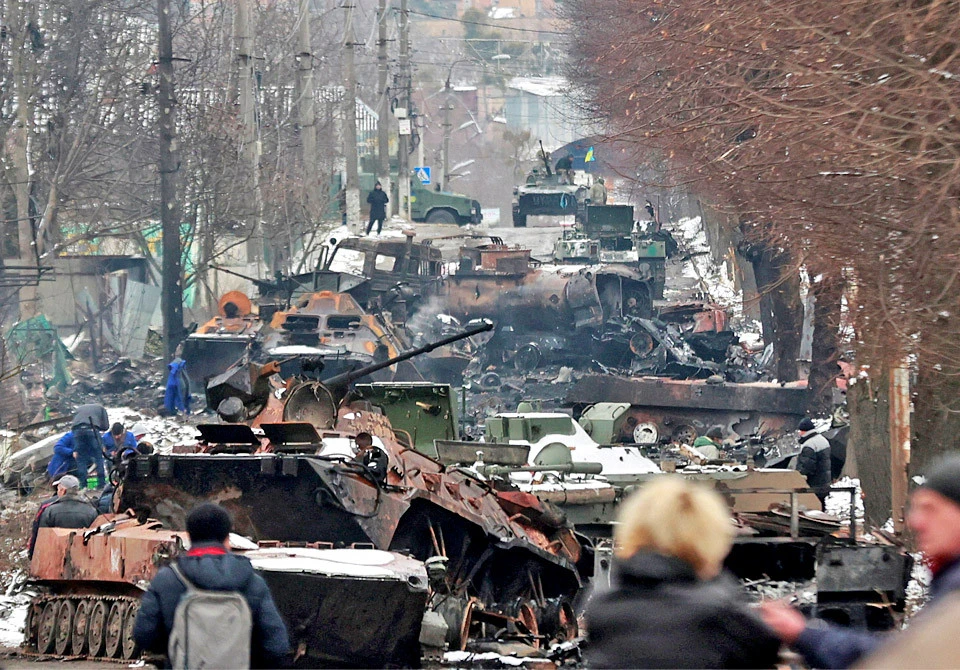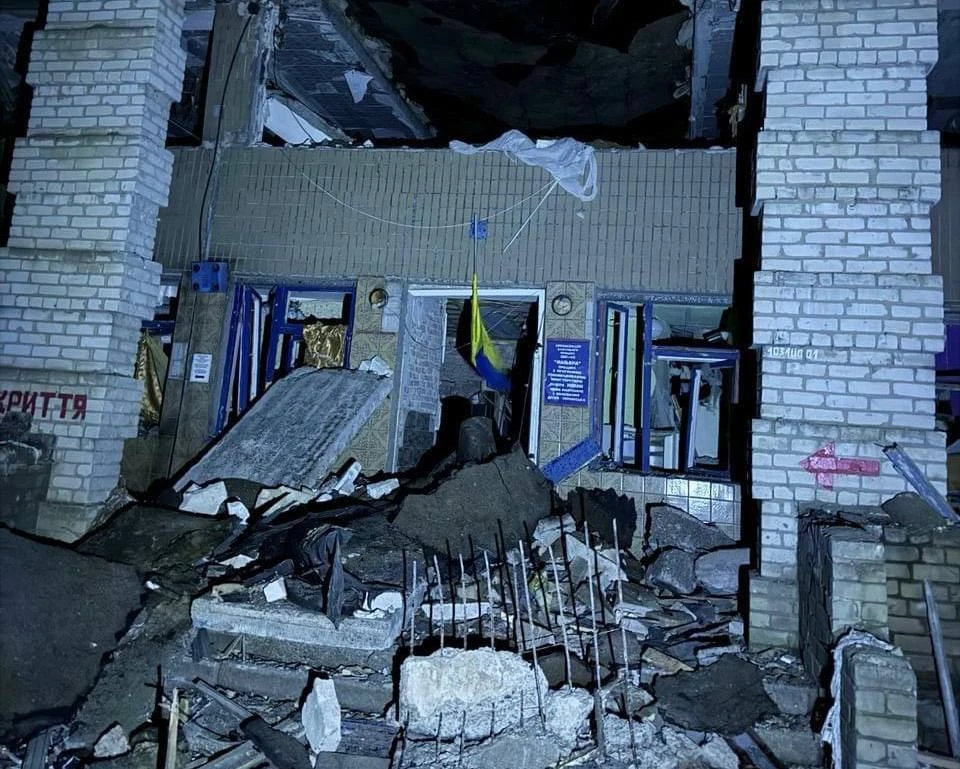
War of fakes: How Russia manipulates facts regarding war against Ukraine
The Russian disinformation machine operates as a multifaceted network designed to sow discord, manipulate opinions, and influence events both domestically and internationally
At its core, this apparatus involves the strategic use of state-controlled media outlets, social media platforms, and covert online operations.
Espreso explains how the Kremlin employs a combination of disinformation and propaganda to achieve its objectives.
Russian military forces consistently target Ukrainian regions using a range of weaponry including attack UAVs, missiles, KABs, and MLRS. The frequency of these attacks increased notably in recent months, resulting in the deaths of dozens and injuries to hundreds more.
Simultaneously, Russia is increasingly becoming the target of attacks itself, with most strikes reported in its regions that border northeastern Ukraine.
However, there is a distinct approach by Russian media and official bodies in covering both its and Ukraine’s attacks, shaping specific narratives of Russia’s “perpetual innocence,” even as it targets civilian hospitals and homes, and the cruelty of the “Kyiv regime” in targeting its “civilian targets.” All this coverage follows a consistent pattern of swapping meanings and disregarding factual information.
The article covers:
-
Russia’s PSYOPs: how do they work
-
Swapping responsibility: Russia blames Ukraine for impossible attacks
-
Russian propaganda twists reality: Selydove attack
Russia’s PSYOPs: how do they work
One tactic frequently observed in Russia's PSYOPs involves deflecting blame for their own actions onto other parties, particularly Ukraine. This strategy is most noticeable in cases where Russia is responsible for civilian casualties or human rights violations. Rather than acknowledging their role, Russian authorities employ a range of techniques to shift responsibility onto Ukraine, often through the dissemination of false information, conspiracy theories, and fabricated evidence.
Russia amplifies narratives that portray Ukraine as the aggressor, framing its own actions as defensive measures or responses to provocations. By exploiting existing tensions, Russian PSYOPs seek to undermine Ukraine's credibility on the global stage while bolstering support for Russia's actions domestically.
In this way, Russia's PSYOPs not only serve to manipulate public opinion but also to justify their own actions while vilifying perceived adversaries. By weaponizing information and blurring the lines between truth and falsehood, Russian authorities continue to wield psychological warfare as a potent tool in pursuit of their objectives.
One instance of disinformation employed by Russia since the beginning of the war is the “human shields” claim. Russia alleges that Ukraine's military employs civilians as shields for “legitimate military targets”. These assertions are echoed in diplomatic circles and on social media, where Russian diplomats aim to depict the Ukrainian resistance as culpable for war crimes, yet scholars and experts widely dismiss these claims as an effort to shift blame for civilian deaths onto Ukraine.

photo: Bucha/Reuters
A notable instance of Russia deflecting its own crimes onto Ukraine involves the atrocities committed by Russian soldiers in Bucha. The pro-Kremlin media, supported by Russian diplomatic social media accounts, accused Ukraine of orchestrating 'false flag' operations to implicate Russia. They presented various explanations, including labeling it as a Ukrainian provocation or a scheme to incite World War III. Some narratives suggest a coordinated assault by Western media or serve as a distraction from alleged "US biological laboratories" in Ukraine.
The distortion of facts reached another peak with the accusations surrounding a Russian drone strike on an apartment building in Odesa on March 2, 2024. The attack resulted in the tragic death of 12 individuals, including five children, and left 20 others injured, among them a pregnant woman.
The victims of the March 2 drone attack include very young children: 4-month-old Tymofiy, 7-month-old Liza, 3-year-old Mark, 8-year-old Zlata, and 9-year-old Serhiy.
Ukrainian journalist and military-political analyst Oleksandr Kovalenko has highlighted attempts by Russian propaganda to distort the narrative surrounding the drone strike, falsely claiming it was caused by a Ukrainian air defense missile and downplaying the drone's capability to cause such destruction. However, evidence at the scene, including remnants of a Shahed-136 kamikaze drone and the pattern of destruction, suggests the use of a thermobaric warhead — a weapon devastating against unfortified structures, making survival in its vicinity almost impossible. An official investigation by Ukrainian authorities is anticipated to shed further light on the incident.
The Kremlin is actively seeking to dominate the information space by inundating it with conflicting "explanations" of events. The objective goes beyond deflecting blame for specific atrocities against peaceful civilians; it also aims to proactively mold narratives to counter and discredit any evidence or investigations into Russian war crimes in Ukraine.
Swapping responsibility: Russia blames Ukraine for impossible attacks
Throughout February Ukraine’s military and intelligence have been actively engaging military targets on Russia’s territory. Particularly affected seems to be the Belgorod region neighboring Ukraine’s northern territories.
The most recent strikes have taken place on February 15 and February 7.
Both the Russian Ministry of Defense and certain Telegram channels have made claims about these instances, displaying notable similarities in their tendency to either ignore or feign ignorance of factual information.
For both attacks, Russia’s official narrative states that the attacks were carried out with the RM-70 Vampire multiple-launch rocket system, causing many victims and significant damage.

The RM-70 Vampire MLRS is a Czech modernized 122-mm MLRS derived from the BM-21 Grad. Ukraine indeed has the Vampire in its arsenal. Based on open-source information, the Ukrainian Armed Forces reportedly acquired several RM-70 Vampire multiple-launch rocket systems from the Czech Republic as early as April-May 2022. These MLRS are actively used by Ukraine's military in operations against Russian forces occupying Ukrainian territory.
This returns us to the claims made by the Russian Ministry of Defense. The Vampire’s projectiles boast a maximum range of 21 km. However, the nearest point on the border between Kharkiv (Ukraine’s northern region that borders Russia) and Belgorod regions to Belgorod itself is 26 km away. In other words, for the RM-70 Vampire MLRS to target Belgorod, it would need to penetrate at least 5 km into Russian territory, explains military and political observer Oleksandr Kovalenko.
The Russian authorities also stated regarding the most recent attack that “air defense assets destroyed 14 [Vampire] projectiles over the territory of the Belgorod region.”
This calls for an important note. It is virtually impossible to shoot down a Vampire projectile with air defense systems. In this scenario, Russian air defense systems might indeed have engaged in firing at targets of their own perception or Ukrainian drones. However, since intercepting anything would have been unfeasible, the SAMs could have self-destructed, potentially falling onto Belgorod. Consequently, such actions could have led to the reported casualties and damage, which Russia blames on alleged attacks by Ukraine.
The notion that Ukraine could have launched an attack on the city from such a remote distance was not only logistically implausible but also contradicted by compelling evidence. Among the evidence were photographs revealing the debris of Russian S-300 missiles, which further support Russian air defense’s involvement and discredit any attempts to attribute blame to Ukraine.
Military expert Petro Chernyk expressed his opinion regarding Russian authorities’ motivations to Channel 24, highlighting that the invaders seek to rationalize their attacks on Ukraine's civilian infrastructure.
"The Russians are orchestrating this themselves. They aim to vilify Ukrainians once more, claiming that the Russians 'have no alternative,’" the expert asserted.
How Russian propaganda twists reality: Selydove attack
As Russia accuses Ukraine of causing civilian casualties with attacks that are physically impossible to carry out, it cynically targets Ukrainian civilian infrastructure, including hospitals, train stations, and homes, resulting in the loss of entire families' lives. All the while, Russia labels these atrocities as "striking legitimate military targets."
“We strike with high-precision weapons at locations where they make decisions, where military personnel and mercenaries gather, at other similar centers, and at military facilities, above all,” said Putin following the Russian army’s attack back in December 2023 that targeted a maternity hospital, a shopping mall, and residential areas, claiming the lives of over 40 civilians, including 30 in Kyiv.
More recently, the Russian propaganda machine launched the so-called “Selydove PSYOP.”
Russia has once again deployed a barrage of misinformation, this time fabricating a narrative of Ukrainian reinforcements en route to Avdiivka being targeted. Media outlets, known for their sympathetic stance towards Russia, have echoed these claims, alleging a devastating attack by Russian forces using "Iskander" missiles near the town of Selydove, Donetsk region.

According to their reports, the city was purportedly sealed off, with Ukrainian authorities accused of attempting to conceal the incident. Margarita Simonyan, a prominent propagandist, even went as far as to suggest that Ukrainian Armed Forces Commander Oleksandr Syrskyi had issued orders to suppress information about the missile strike.
Russian sources have sensationalized the alleged attack, asserting that as many as 1,400 to 1,500 Ukrainian fighters had congregated at the training ground, poised to reinforce Avdiivka. They claim that Russian forces, using "Iskander" missiles, inflicted casualties amounting to 80% of the reinforcements.
However, the reality paints a starkly different picture. It was not Ukrainian military personnel who bore the brunt of the attack, but rather innocent civilians residing in residential areas of Selydove. Reports indicate that the missiles struck a hospital's maternity ward where approximately 200 people were present, resulting in three tragic deaths and twelve injuries, including four children. Another strike leveled a five-story building and caused extensive damage to nine others.
In a maneuver aimed at perpetuating their deceptive narrative, Russia went to great lengths by endeavoring to pin blame on Ukraine's recently appointed Commander-in-Chief, Syrkyi.
This intentional manipulation of truth serves several purposes. Firstly, it seeks to portray Avdiivka as beyond salvation, casting doubt on any potential for resolution in the region. Secondly, it aims to erode Ukrainian morale precisely at a time when unity and determination are vital during general mobilization efforts. Additionally, this tactic aims to sow seeds of discord and confusion among international observers, clouding their understanding of the situation and potentially undermining unified action against Russia's aggression.
Such calculated efforts demonstrate Russia's willingness to exploit misinformation to further its agenda at the expense of truth and stability.
How much money does Russia spend on disinformation campaigns and how does it spread them
In 2022, as Russia launched a full-scale war against Ukraine, there was a substantial increase in Russian propaganda spending. A study by Debunk project analysts revealed that the Kremlin's propaganda expenditure for the year reached USD 1.9 billion, surpassing the initially set budget of USD 1.5 billion. Moving into 2023, the Russian state budget allocated USD 1.6 billion for state media, with over 51% directed towards three main agencies: the All-Russian State Television and Radio Broadcasting Company, RT (Russia Today), and Rossiya Segodnya.
In June 2023, Ukrainska Pravda disclosed that Russia intends to allocate almost RUB 80 million (USD 987,000) to effectively bribe foreign journalists. These funds aim to incentivize journalists to provide 'objective' coverage and broadcast a 'positive agenda' to enhance Russia's influence.
On February 24, Ukrainian intelligence services issued a joint statement, revealing that Russia has spent USD 1.5 billion on information operations against Ukraine, expected to culminate in March-May.
In this way, Russia seeks to mold the narrative, subsequently reflected in press coverage and legitimized across Western media platforms.
Various sources of disinformation and propaganda include official state media from Russia, some of which faced temporary bans on specific platforms since the onset of the Russian invasion. However, numerous non-official websites actively disseminate false content in support of Vladimir Putin's government. These sources encompass anonymous websites, foundations, and research sites with unclear funding, some having undisclosed ties to the Russian government. Notably, influential sites known for sharing pro-Russian propaganda and disinformation, such as RT, TASS, and Sputnik News, receive funding from the Russian government.
Besides, government-funded sites adeptly leverage digital platforms like YouTube, Facebook, X (formerly Twitter), and TikTok to facilitate the widespread dissemination of deceptive narratives.
Research data from the University of Adelaide in Australia, along with information from open data sources like NewsGuard and RAND, confirmed an instance when pro-Russian accounts spread disinformation about the war in Ukraine, spending approximately USD 100,000 on Facebook advertising alone. The research also identified over 1,000 personal pages involved in spreading disinformation in Europe.
To spread its narratives, Russia also utilizes various platforms such as messengers, social networks, and Telegram channels. The strategy often involves cross-posting, where content disseminated on one platform is rapidly picked up by others. Notably, TikTok remains a promising platform for promoting PSYOPs due to its widespread popularity across countries.
Telegram remains a prevalent platform for spreading harmful influences. Channels are created for both spoofing and mimicking real channels of military units, official institutions, or notable figures. The platform's accessibility and anonymity enable the rapid creation, distribution, and promotion of anonymous content, making it difficult to verify or legitimately check.
- News













































